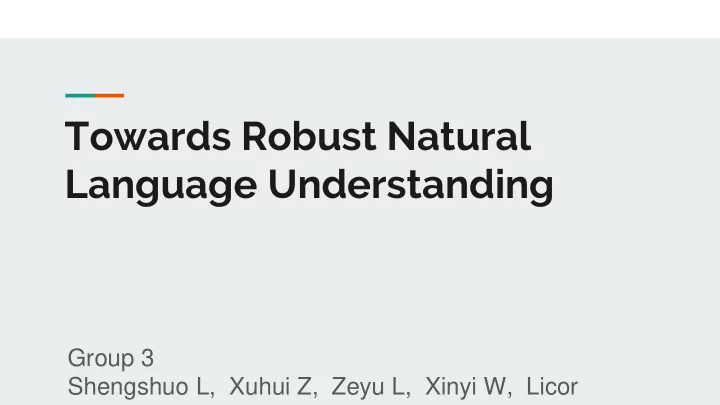

Towards Robust Natural Language Understanding Group 3 Shengshuo L, Xuhui Z, Zeyu L, Xinyi W, Licor
So, why do we need robustness? Goodfellow, I. J., Shlens, J., & Szegedy, C. (2014). Explaining and harnessing adversarial examples. arXiv:1412.6572.
Text Classification ● detection of offensive language Hosseini, H., Kannan, S., Zhang, B., & Poovendran, R. (2017). Deceiving google's perspective api built for detecting toxic comments. arXiv:1702.08138.
Text Generation ● emit offensive language
Commonsense Reasoning ● dual test cases ● the correct prediction of one sample shou should lead to correct prediction of the other (actually not not ) Zhou, X., Zhang, Y., Cui, L., & Huang, D. (2019). Evaluating Commonsense in Pre-trained Language Models. arXiv:1911.11931.
And, why does this happen? ● Nowadays benchmarks are overinflated with similarly (and easy) problems ○ Human annotation process is not always a safe take ● Linear nature of Neural Networks (we can do nothing about this currently) Gururangan, S., Swayamdipta, S., Levy, O., Schwartz, R., Bowman, S. R., & Smith, N. A. (2018). Annotation artifacts in natural language inference data. arXiv:1803.02324.
It’s hard, isn’t it? Break it by creating adversarial dataset!
SWAG ● grounded commonsense inference ● predict which event is most likely to occur next in a video Zellers, R., Bisk, Y., Schwartz, R., & Choi, Y. (2018). Swag: A large-scale adversarial dataset for grounded commonsense inference. arXiv:1808.05326.
SWAG ● annotation artifacts and human biases found in many existing datasets ● aggressive adversarial filtering Zellers, R., Bisk, Y., Schwartz, R., & Choi, Y. (2018). Swag: A large-scale adversarial dataset for grounded commonsense inference. arXiv:1808.05326.
WinoGrande robust commonsense capabilities or rely on spurious biases (with ✗ in the example below) ● ● improve both the scale and the hardness of the WSC Sakaguchi, K., Bras, R. L., Bhagavatula, C., & Choi, Y. (2019). WINOGRANDE: An adversarial winograd schema challenge at scale.
WinoGrande AFLITE ● adopt a dense representation of instances using precomputed neural network embeddings ● an ensemble of linear classifiers (logistic regressions) trained on random subsets of the dataset-specific bias detected by AFLITE (marked with ✗ ) data Sakaguchi, K., Bras, R. L., Bhagavatula, C., & Choi, Y. (2019). WINOGRANDE: An adversarial winograd schema challenge at scale.
1. Word Importance Ranking 2. Word Transformer (replacement) ○ TextFooler have similar semantic meaning with the original ○ fit within the surrounding context ○ force the target model to make wrong predictions Di Jin (2019). Is BERT Really Robust? A Strong Baseline for Natural Language Attack on Text Classification and Entailment. arXiv:1907.11932
Build it Break it Fix it ● a training scheme for a model to become robust ● iterative build it, break it, fix it strategy with humans and models in the loop Dinan, E., Humeau, S., Chintagunta, B., & Weston, J. (2019). Build it break it fix it for dialogue safety: Robustness from adversarial human attack. arXiv:1908.06083.
● provide a theoretical understanding ● proves models trained on the filtered AFLite Investigation datasets yield better generalization Bras, R. L., Swayamdipta, S., Bhagavatula, C., Zellers, R., Peters, M. E., Sabharwal, A., & Choi, Y. (2020). Adversarial Filters of Dataset Biases. arXiv:2002.04108.
But wait! There’s one more thing Accuracy isn’t everything
Accuracy is not the direct measure for robustness. Consistency is!
Definition of consistency: Question A and A’ are a dual test pair A consistent case would be: Model get both A and A’ right or wrong A: He drinks apple. A’: It is he who drinks apple.
Consistency and accuracy are not the same. Trichelair, P., Emami, A., Trischler, A., Suleman, K., & Cheung, J. C. K. (2018). How Reasonable are Common-Sense Reasoning Tasks: A Case-Study on the Winograd Schema Challenge and SWAG.
Consistency and accuracy are not the same. Trichelair, P., Emami, A., Trischler, A., Suleman, K., & Cheung, J. C. K. (2018). How Reasonable are Common-Sense Reasoning Tasks: A Case-Study on the Winograd Schema Challenge and SWAG.
Our next step towards final project Measure the consistency of BERT & GPT-2 using our own dataset
Recommend
More recommend